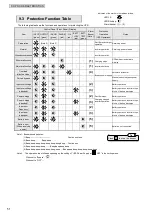
_
6. INSPECTION AND MAINTENANCE
_
36
6
6
.
.
1
1
R
R
o
o
u
u
t
t
i
i
n
n
e
e
C
C
h
h
e
e
c
c
k
k
s
s
b
b
y
y
C
C
u
u
s
s
t
t
o
o
m
m
e
e
r
r
CAUTION
!
Never inspect the inside of the UPS.
Doing so may result in an electric shock, burn, injury, fuming, or fire.
Do not touch the fan on the back of the UPS when cleaning the UPS or anywhere around the UPS.
It may result in bodily injury.
Do not use, for example, a wet cloth for cleaning. Failure to do so may result in electrical shock.
When cleaning, do not connect a vacuum cleaner to the output terminal of the UPS.
Doing so may result in smoke and/or a fire.
Check the following items on a daily basis.
Check Item and Description
Countermeasure
Is the LED lit state of the control panel abnormal?
See “8. Troubleshooting” and perform the countermeasure.
Is a buzzer beeping?
If a buzzer is beeping, see “7. When a Buzzer Sounds” and perform the
countermeasure.
Is the UPS producing abnormal vibration or emitting
abnormal heat, a strange noise, or a strange odor?
If there is an abnormality, immediate stop the UPS and contact your
sales representative or SANYO DENKI.
Is the exterior in any way damaged or deformed?
If there is any damage such as a dent or deformation that may affect the
UPS interior, contact your sales representative or SANYO DENKI. Do
not use the UPS as is. Doing so is dangerous.
Does the UPS have a suitable surrounding environment?
The operating temperature is -10 to 55°C (14 to 131 F), and the relative
humidity is 20 to 90%.
If the installation environment is not suitable, there is danger of the UPS
malfunctioning.
If the installation location is in an environment such as the following,
improve the environment.
See “3.1 Checking the Installation Environment”.
Where the ambient temperature exceeds 55 C (131 F)
Where there is high humidity
Where there is a great amount of dust
Where salt or corrosive gas is present
Where there is vibration or impact
Where the UPS may get wet, or a place with the risk of
condensation.
In a poorly ventilated rack.
A place that exceeds an elevation of 2000 m
On a ship or in an airplane, moving vehicle, or the like, or in some
other special environment
Has the specified amount of space been provided at the front
and back?
Are objects stacked around the UPS or are the vents blocked
by obstacles?
Check the specified amount of space surrounding the UPS while
referring to “3. UPS Installation”.
Remove any objects stacked around the UPS or obstacles blocking the
vents.
If the air intake and exhaust space of the fan is blocked, the internal
temperature of the UPS will rise, which may cause smoke, a fire or a
malfunction of the UPS.
Is there any dust or dirt adhering to the air intake and fan
exhaust vents on the front panel or back, the plugs, or the
outlets of the UPS?
Remove any adhering dust or dirt.
Dust or dirt adhering to parts inside the UPS SYSTEM may result in
malfunction of the UPS SYSTEM. Additionally, dust adhered to the
plugs or outlets results in the risk of a fire.
Are any of the input plugs or power cords of the load
equipment pinched or smashed?
A damaged input plug or power cord results in the risk of an electric
shock and/or a fire.
If something is leaning against a cable or unreasonable force is applied
to a cable, improve the situation.
Have the batteries deteriorated?
Is the UPS in a state that allows backup of the load
equipment in the event of a power outage?
See “6.2 Inspecting the Batteries” and check the state of the batteries.
















































